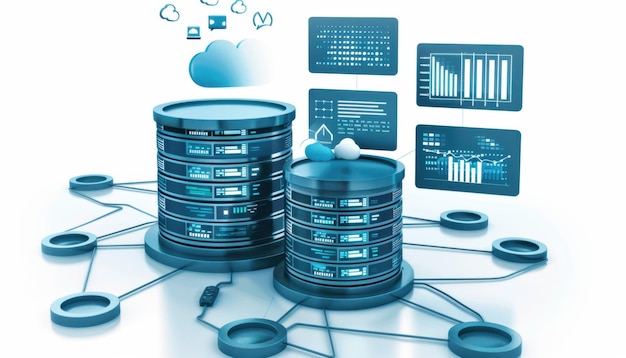People sometimes speak about databases, making it sound very technical; however, it is roughly the same thing as keeping your notes in order or keeping track of all your favourite books. Databases help people store, manage, and make use of the information in a smart way. To get a basic idea about database management, let’s break things into simple concepts.
How Database Works?
Imagine you have a very large box where you collect all your books, stationery, and notes. In case you simply dump everything in the box and nothing is organized at all, it would be very difficult to find what you want. You could even take a set time in search of some important notes or your favourite pen. Now, imagine you have different folders or sections in your box: one for notes with subdivision marking one for math, one for science, and one for art. It is, thus, easy to find whatever you want. That is somewhat how a database works but in an advanced way.
Database is like a digital version of your box with different folders where everything is perfectly organized because instead of using physical folders, it may organize the information in tables. When you use the term ‘tables’, you’re actually referring to spreadsheets. Data is usually arranged in rows and columns. Each row hane piece of information, like one student’s information in this case, and each column holds data about that person, such as name, age, and grade. Now everything is so organized, and you don’t have to worry about losing anything.
Database Management
A Database Management System (DBMS) is one of the important tools required to manage and work with databases. Think of database management system as an efficient librarian who knows everything about where things are in the library. It helps you add new information, find old information, and keeps everything in order.
Features of Database Management Syste ms
- Smart Management
One of the most basic concepts of DBMS is the idea of data and its management. Data is mere information which can be as simple as a phonebook of your friends to the details about your favourite books. Managing it means to actually keep it within the right place where it is easy to access, and safe from loss or damage.
- Data Integrity
Another key feature in this regard is data integrity. This means that information added in the database is correct and reliable. For instance, if you enter the age of the student as 13, then the database will not allow you to enter this as 100 by mistake. This ensures that the information added is correct and constant.
- Data Security
Another important term counting in the features of DBMS is data security. You lock up your diary to prevent your secrets from leaking out, the same goes for databases so that the information stored within is secure. Data security refers to the fact that only the right people should be allowed to read or write the information. This way the personal information is not exposed or changed.
- Data Retrieval
A crucial feature to consider is data retrieval. It pertains to the searching and obtaining of information from the database. Suppose you want to look up the name of a friend so you can get their phone number. If it is a well-set database, you would simply search his name and have his number within seconds. This is just what data retrieval is all about; getting the needed information quickly and accurately.
- Data Manipulation
A DBMS also allows one to manipulate their data. This could involve entering new information, modifying existing information, or deleting information that is no longer valid. For instance, when you get a new number, you can update your list by adding this into your contacts in the database. When one of your friends moved away, you can delete all the relevant details. This would be of crucial eminence in keeping the database up-to-the-minute.
- Database Normalization
You may also come across the term database normalization while understanding about a DBMS. What normalization does is that it is much like tidying and organizing your room – making sure everything is in its right place. Giving out redundancy is the removal of data along with any sort of inconsistency or ambiguity. Normalization organizes data so that it is efficiently stored without unnecessary repetition.
- Querying Databases
Also, it is equally important to learn how to query a database. Basically, you send a question to the database that you need the information about. You need to know, for instance, on an examination, who has scored over 90. You will write a query to get that information from the database. By learning to create and run a query, you can quickly access the exact data you want.
- Transaction
Another feature is transactions. In a database, a transaction consists of a number of related actions that have to be treated as a single unit. For example, if you’re adding a new student, all the pieces of their information need to be put into the database. If anything goes wrong, the transaction can go back; it cancels all the actions to ensure correctness and consistency of its data.
- Backup and Recovery
Just like important documents are duplicated for backup in case they are lost, databases need backups so that the information is not lost. Backup is the process whereby the database is copied, but recovery is the mechanism for restoring the database from the backup copies when things have gone wrong.
Centralized And Distributed Databases
Finally, it is good to know that a DBMS has different use cases. Some databases are ‘centralized’ where the data is stored in one central location and accessed from that location. Other databases are ‘distributed’ where the data is spread across many locations but still work together. Based on the usage and management of data, the choice has to be made.
In essence, management of a database amounts to the level of understanding in the organizational structure, administration, and security of data. A DBMS maintains everything in place by facilitating the storage, retrieval, and manipulation of data with ease. Important concepts underpin a smoothly running, secure database and involve issues of integrity, security, retrieval, and backup. Knowing this kind of very basic concepts, one appreciates the way databases work and how they can help manage information effectively.



